Ethereum has unique advantages that can provide global financial infrastructure for this new digital dollar economy, and ETH will directly benefit from this growth.
Authors: Maria Shen & Sanjay Shah, Electric Capital
Compiled by: Deep Tide TechFlow
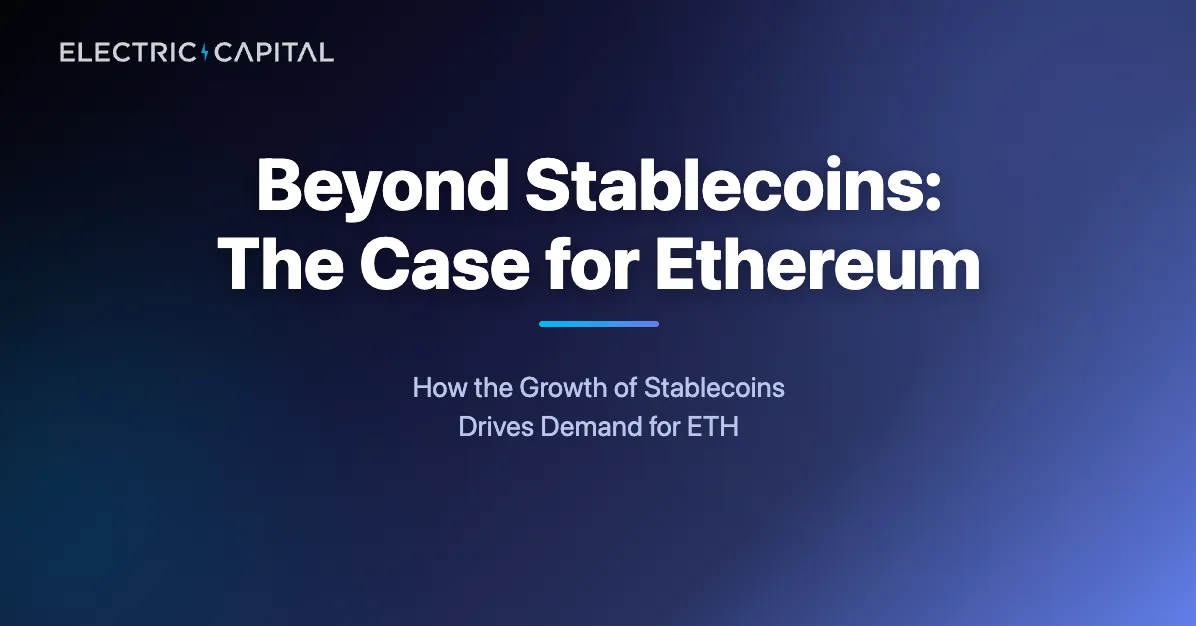
*Note: In this article, "Ethereum" refers to the network, while "ETH" refers to the asset that powers it.
The global demand for the dollar has not only not decreased but has exploded. While news headlines focus on "de-dollarization," a more important trend is emerging: over 4 billion people and millions of businesses are actively seeking to access dollars through stablecoins, representing the largest expansion of the dollar's network effect in decades.
This creates unprecedented opportunities for Ethereum. Stablecoins provide a channel for individuals worldwide to access dollars—growing 60 times since 2020, exceeding $200 billion—millions of new dollar holders need more than just digital cash. They need yields, investment opportunities, and financial services. Traditional finance cannot serve this vast new market due to regulatory and infrastructure limitations.
Ethereum has unique advantages that can provide global financial infrastructure for this new digital dollar economy, and ETH will directly benefit from this growth.
Millions of new dollar holders enter through stablecoins
There is enormous potential demand for dollars from individuals and businesses worldwide.
People around the world want to secure their wealth in dollars:
Over 4 billion people face significant currency risk due to political instability, poor monetary policy, and structural inflation. (1)
An estimated 21% of the global population lives in countries with annual inflation rates exceeding 6% (2), rapidly eroding savings and purchasing power.
For these populations, holding dollars means financial security. The dollar is seen as a means of storing value, a medium for cross-border transactions, and a hedge against local currency volatility.
Businesses need dollars for transactions:
The dollar remains the dominant currency in global trade, with 88% of foreign exchange transactions involving at least one party using dollars. (3)
Businesses in emerging markets rely on dollar liquidity for international payments, imports, and supply chains, while local banks and foreign exchange markets in these markets are often limited or unstable.
Small and medium-sized enterprises and freelancers increasingly need digital dollars to receive payments and avoid currency mismatch risks.
For the first time in history, anyone in the world can hold dollars through stablecoins:
Anyone with internet access can hold and trade dollars—no banks, no government permission, available globally 24/7.
As a result, the market capitalization of stablecoins has grown 60 times since 2020. (4)
Adoption peaks in emerging markets that were previously excluded from dollar-denominated finance. Nigeria has become the second-largest cryptocurrency market globally, while China continues to see underground cryptocurrency usage despite bans. (5)
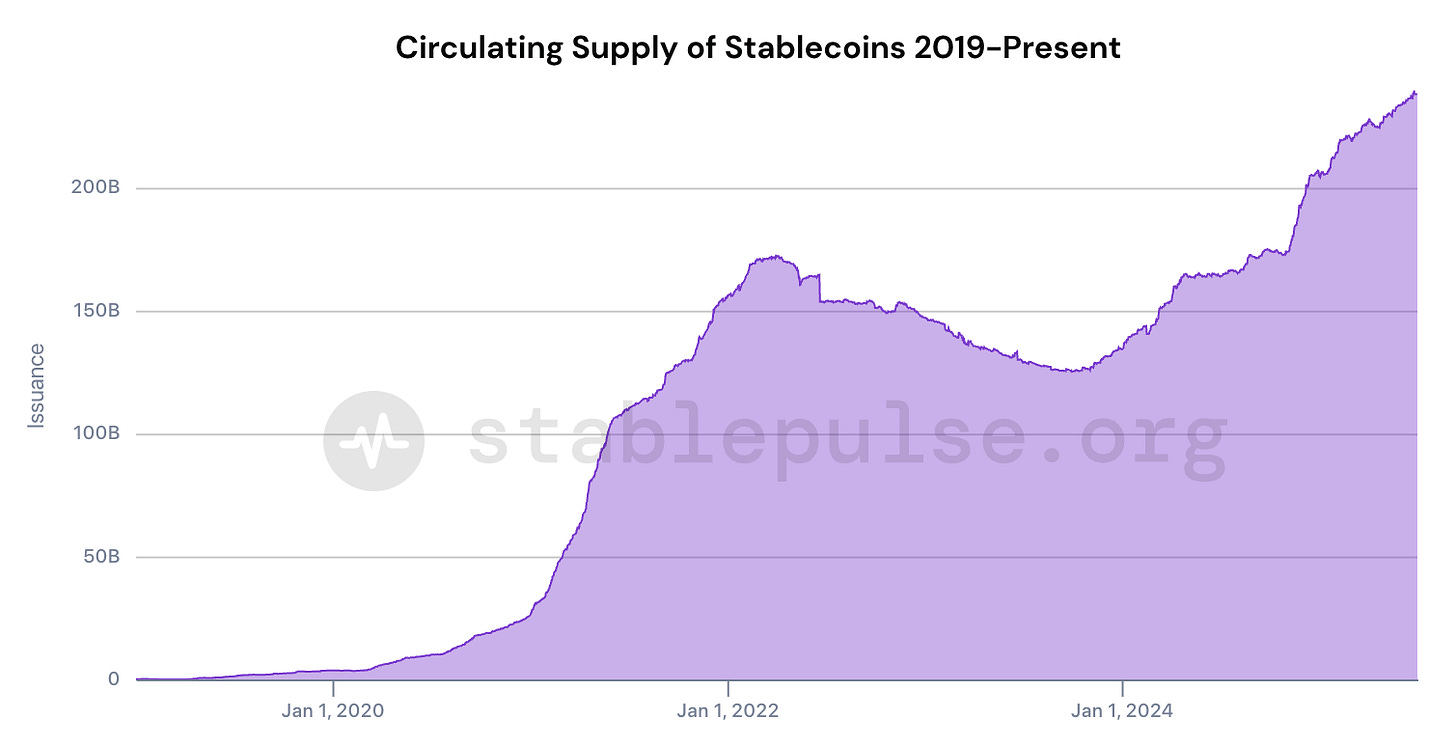
Stablecoins are creating a new group of dollar holders among the world's largest population groups—businesses pricing in USDT and households saving in USDC. They are driving a fundamental expansion of the dollar financial services market.
These new dollar holders seek yields, creating opportunities for new global financial infrastructure
Stablecoin holders want their money to work for them.
Today, millions can hold dollars through stablecoins. But their aspirations go far beyond that. Individuals and businesses naturally want to put their funds to work to earn yields, invest, and grow wealth.
Traditional finance cannot serve this new market:
The U.S. banking system requires compliance with regulations, excluding most global participants.
Cross-border financial services remain expensive, slow, and geographically restricted.
Traditional finance is built for institutions and high-net-worth individuals, not global retail.
Geographic and regulatory barriers hinder billions of dollars from participating in dollar-denominated financing.
This creates a demand for new financial infrastructure that can serve billions of global stablecoin holders, enabling them to put new dollars to work.
Only Ethereum meets all three requirements to serve global stablecoin holders
New financial infrastructure serving stablecoin holders must meet three key requirements:
Globally available—must be accessible from anywhere with internet access, from New York to Nigeria to rural Nepal. Most regions of the world lack access to dollar-based financing due to geographic or regulatory reasons.
Safe for institutions—must provide the security, reliability, regulatory clarity, and customizability needed for institutions to build financial products worth billions of dollars.
Resistant to government intervention—must not be controlled by any single government, as many governments prefer to restrict the circulation of dollars to protect local currencies and control capital flows.
Ethereum meets all three requirements:
Globally accessible: Anyone with an internet connection can use Ethereum 24/7.
Safe for institutions:
Secure—has the highest economic security and decentralization among all programmable blockchains. The most mature security infrastructure—with the most open-source developers, verified contracts, security auditors, and tools.
Reliable—maintains 100% uptime for 10 years, regardless of market crashes or geopolitical events.
Regulatory compliant—U.S. regulators classify ETH as a commodity, providing a clear institutional framework.
Customizable—Ethereum's L1+L2 framework allows for customization, enabling institutions to optimize for specific use cases and meet regulatory requirements (e.g., both Coinbase and Robinhood have built L2 chains on Ethereum).
Proven track record—home to the world's largest digital financial economy: stablecoins with a market cap exceeding $140 billion (6), over $60 billion invested in decentralized finance (DeFi) protocols (7), and over $7 billion in tokenized real-world assets. (8)
Resistant to government intervention: No single government can seize a control point to control or restrict the network.
Ethereum uniquely meets these requirements with its strong decentralization features—its origin story is nearly impossible to replicate today.
The strong decentralization of Ethereum makes it globally accessible, secure, reliable, and resistant to government intervention.
This level of decentralization is rooted in Ethereum's origins and culture.
Ethereum was originally a community-funded blockchain that adopted a proof-of-work mechanism, which allowed for very broad asset ownership. However, the current environment makes it unsuitable to launch in this way.
Its culture has always prioritized decentralization—maintaining costly customer diversity and resisting centralized shortcuts—making this culture nearly impossible to transform.
As a result, Ethereum possesses a decentralization advantage that other chains cannot easily replicate, providing Ethereum with a lasting moat.
No other alternative can simultaneously meet all three requirements:
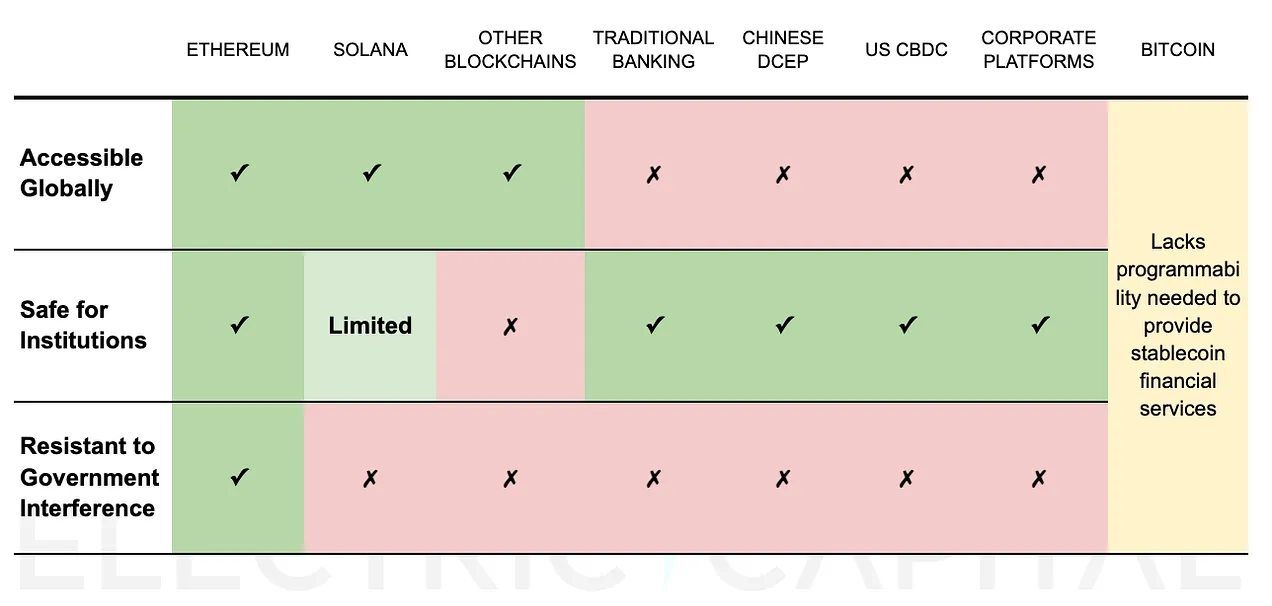
* Bitcoin may become more programmable in the future, but only if the Bitcoin community agrees to change the opcode to enable this.
As ETH becomes the reserve asset of the new digital dollar economy, its demand may increase
What is a reserve asset?
In any financial system, a reserve asset is the trusted foundational layer that supports everything. It is collateral, savings, or liquidity assets held by institutions, protocols, and users for value storage, loan collateral, and transaction settlement.
In traditional systems, examples of reserve assets include the dollar, U.S. Treasury bonds, and gold, as they are trusted, highly liquid, and widely accepted.
Why ETH naturally plays this role
As billions of dollars flow through stablecoins on Ethereum, participants need a secure, permissionless, and efficient asset to support lending, staking, and yield generation. ETH has inherent advantages in this regard because:
Scarce and trustworthy: The supply of ETH is predictable, with low inflation and no central control.
Productive: Unlike gold or static dollars, ETH generates yield through staking—similar to earning income from holding real estate or government bonds.
Collateral utility: ETH is already the largest on-chain collateral asset in the Ethereum ecosystem, supporting lending protocols worth $19 billion (12). Institutions hold it because they need it to enter the DeFi market.
Anti-seizure and anti-censorship: ETH cannot be frozen or seized by governments, making it more resilient than centrally issued assets.
Programmable and highly liquid: ETH is deeply integrated into the entire on-chain financial system, offering unparalleled liquidity for large transactions.
Why this makes ETH valuable
As more users hold stablecoins and require financial services, they need a reserve asset to support these activities. ETH can earn yield, secure the network, and support DeFi lending—thus, as the system evolves, demand for ETH will naturally grow.
In simple terms: more stablecoin adoption → more on-chain activity → more demand for ETH as collateral → institutions and users hold more ETH.
L2s expand demand for ETH
The growth of Ethereum Layer-2 further stimulates demand for ETH. By lowering transaction costs, speeding up transaction times, and enabling new use cases, Layer-2 opens up more areas where ETH can be used as collateral. This expands the reach of ETH and strengthens its position as a reserve asset in the digital dollar economy.
As demand for ETH increases, it is also expected to become a global store of value
The growing demand for ETH also allows it to capture a significant share of the traditional store of value market.
Like Bitcoin, Ethereum has superior store of value (SoV) characteristics compared to traditional assets like gold.
ETH and BTC do not compete with each other but may share a slice of the $500 trillion traditional SoV asset market (gold, Treasury bonds, stocks, real estate) in the coming years.
In addition to having Bitcoin's SoV attributes, ETH also provides yield to holders.
Yield generation is a significant advantage, as investors generally favor income-generating assets. U.S. households hold about $32 trillion in dividend-paying stocks (13), while the value of the gold they hold is less than $1 trillion.
ETH has characteristics superior to traditional SoV assets and can provide yield:

Conclusion: Holding ETH may be the best way to participate in the growing stablecoin economy
The growth of the stablecoin economy has established a strong flywheel for Ethereum and ETH.
As more stablecoins are deployed on Ethereum, demand for ETH increases. Higher ETH value and a more secure network attract more institutions and services, further driving the adoption of stablecoins.
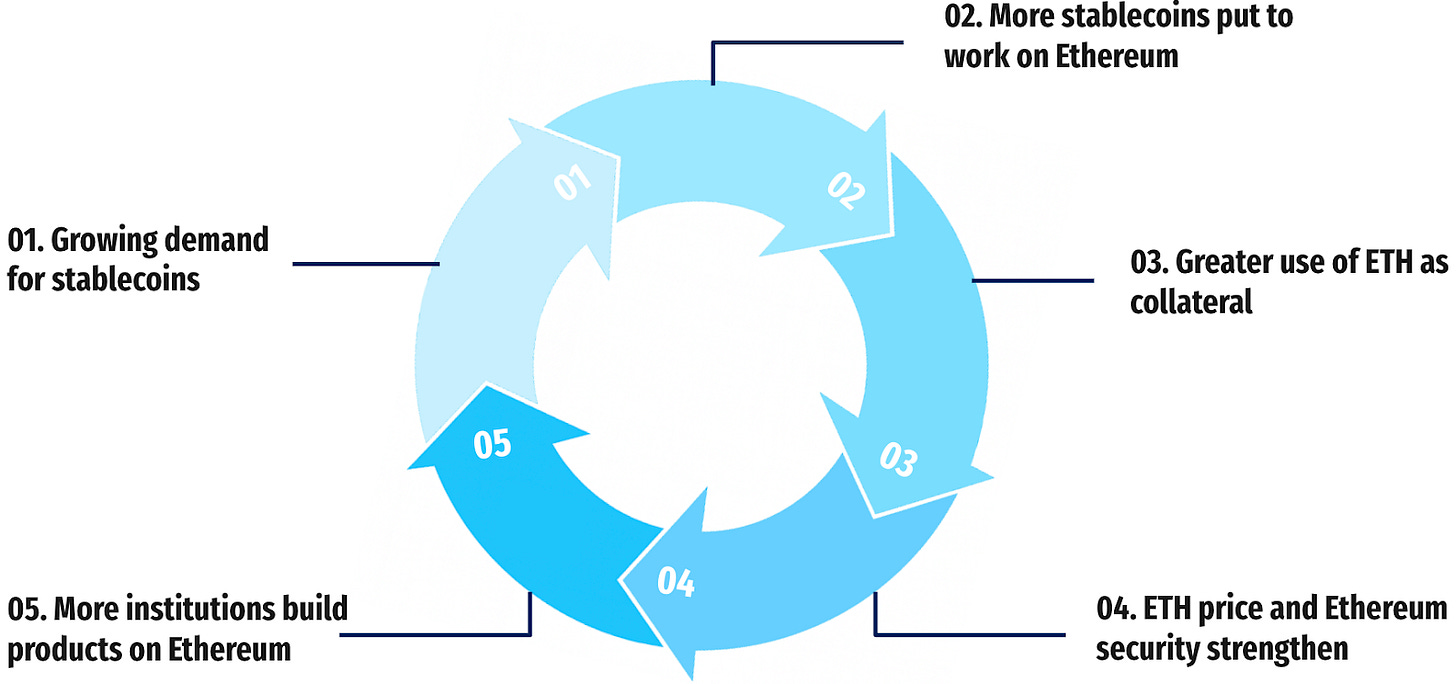
Alternatives face significant challenges in replicating this flywheel:
Traditional finance cannot serve billions of people excluded due to geographic and regulatory barriers.
Government-controlled systems remain subject to political influence and jurisdictional limitations.
Bitcoin lacks the programmability for complex financial services.
Other blockchains lack the security, reliability, and customizability required by institutions, as well as the decentralization needed to resist government intervention.
The result is: Holding ETH may be the simplest and most effective way to access the growing stablecoin economy.
You could also choose to invest in specific DeFi protocols that benefit from the expansion of stablecoins. However, this carries higher risks and requires expertise.
For most retail and institutional participants, ETH provides the easiest access to the entire digital dollar ecosystem.
Appendix
Risks to Consider
Like any emerging global system, Ethereum faces significant risks. Despite the many risks, three major risks pose the greatest threat to the argument that "Ethereum will use ETH as a reserve asset to build a permissionless, dollar-based financial system."
- The dollar becomes the reserve asset, not ETH
If stablecoins like USDC or USDT dominate and are used for lending, collateral, and settlement, the dollar may replace ETH as the reserve asset of the system. In this case, ETH might be seen primarily as "gas money" rather than a core store of value. However, given that ETH accounts for 44% of on-chain lending collateral on the Ethereum mainnet and Layer 2, generating a staking yield of 3-5%, replacing ETH seems quite challenging. More importantly, ETH is the only truly decentralized asset on Ethereum—stablecoins like USDC and USDT are centralized and can be frozen or seized, fundamentally preventing them from fulfilling ETH's role as anti-censorship collateral. It is more likely that ETH and the dollar will play complementary roles—the dollar focused on stability and transaction optimization, while ETH provides decentralized, anti-seizure value storage and network ownership.
- CBDC competition replaces the adoption of dollar stablecoins
Central Bank Digital Currencies (CBDCs) could provide similar 24/7 access to digital dollars, fully backed by sovereign support, which could crowd out private stablecoins and limit the permissionless dollar system currently supported by Ethereum. CBDCs are inherently national and often lack true cross-border interoperability, and they may restrict access for open developers due to compliance and identity requirements. In contrast, stablecoins have settled trillions of dollars annually, operating globally by default, and maintain greater flexibility in innovation, making it difficult for CBDCs to replace them.
- Competing chains surpass Ethereum
A blockchain that is faster, cheaper, and initially less decentralized may attract users and developers who prioritize low fees and a simple user experience, creating strong liquidity and network effects in the early stages. Over time, this chain may be able to mature its validator set sufficiently to reach a level of "sufficient decentralization," thereby undermining Ethereum's dominance. However, given Ethereum's level of decentralization and over a decade of proven security, replacing it is no easy task.
Additional Data
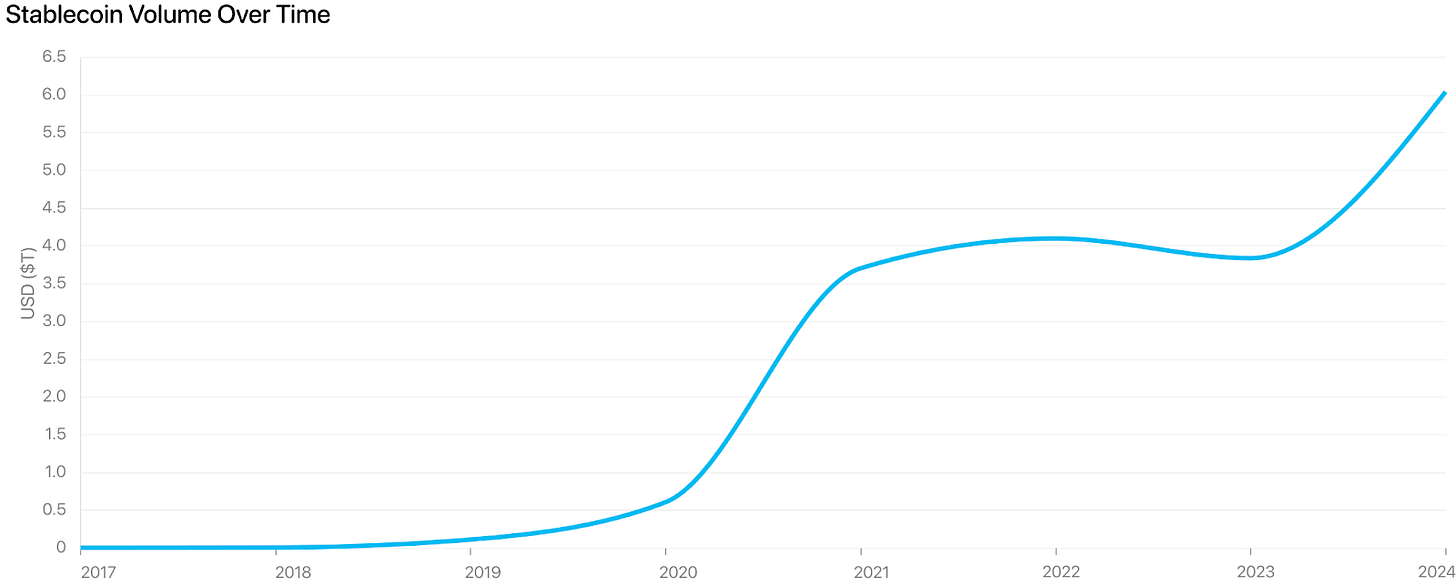
Annual stablecoin settlement volume exceeds $6 trillion (a tenfold increase since 2020): (14)
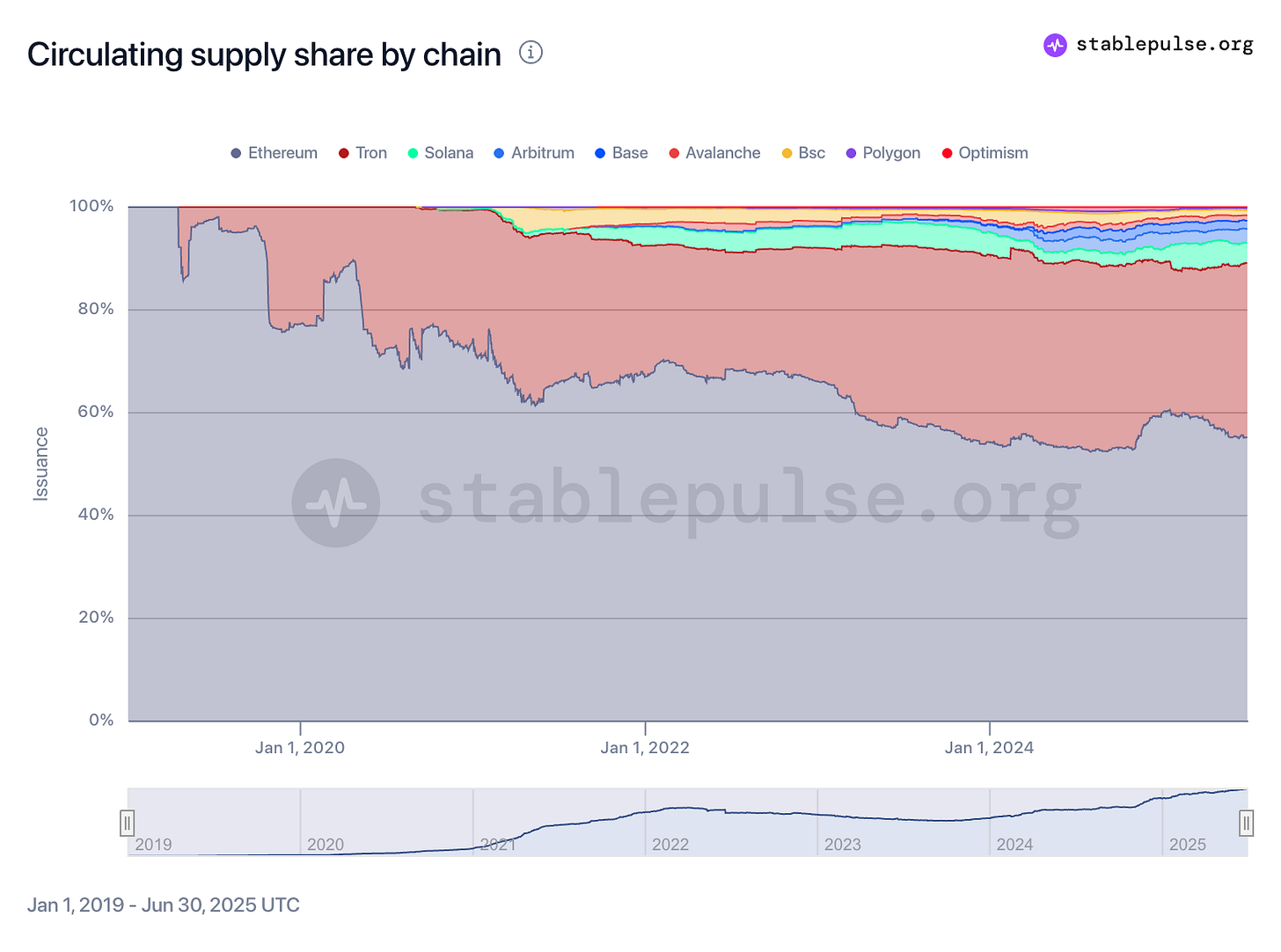
Ethereum holds over 55% of stablecoins: (15)
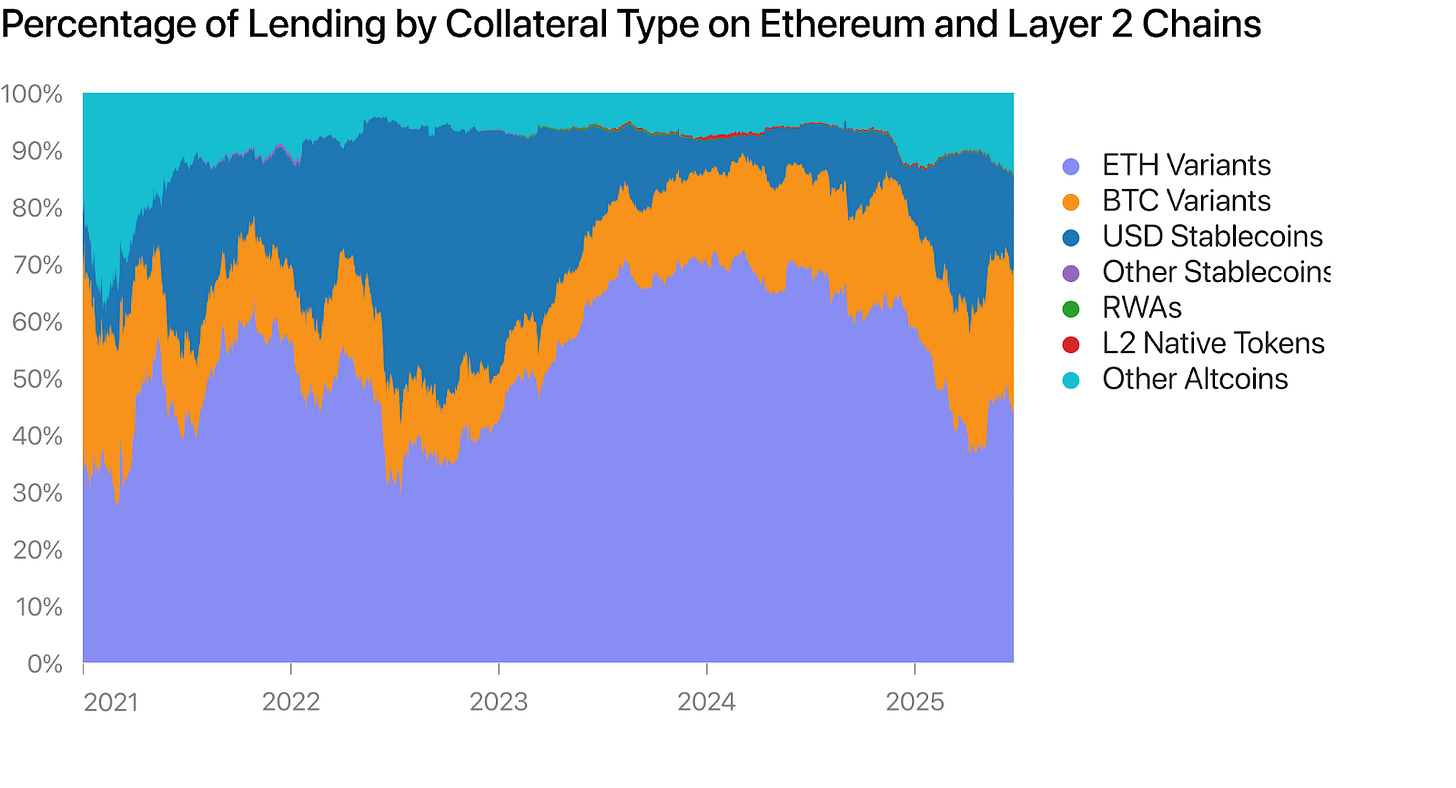
ETH may become the reserve asset of the new financial system. 44% of the collateral in the Ethereum ecosystem is ETH, making it the largest collateral asset ($19 billion): (16)
免责声明:本文章仅代表作者个人观点,不代表本平台的立场和观点。本文章仅供信息分享,不构成对任何人的任何投资建议。用户与作者之间的任何争议,与本平台无关。如网页中刊载的文章或图片涉及侵权,请提供相关的权利证明和身份证明发送邮件到support@aicoin.com,本平台相关工作人员将会进行核查。




